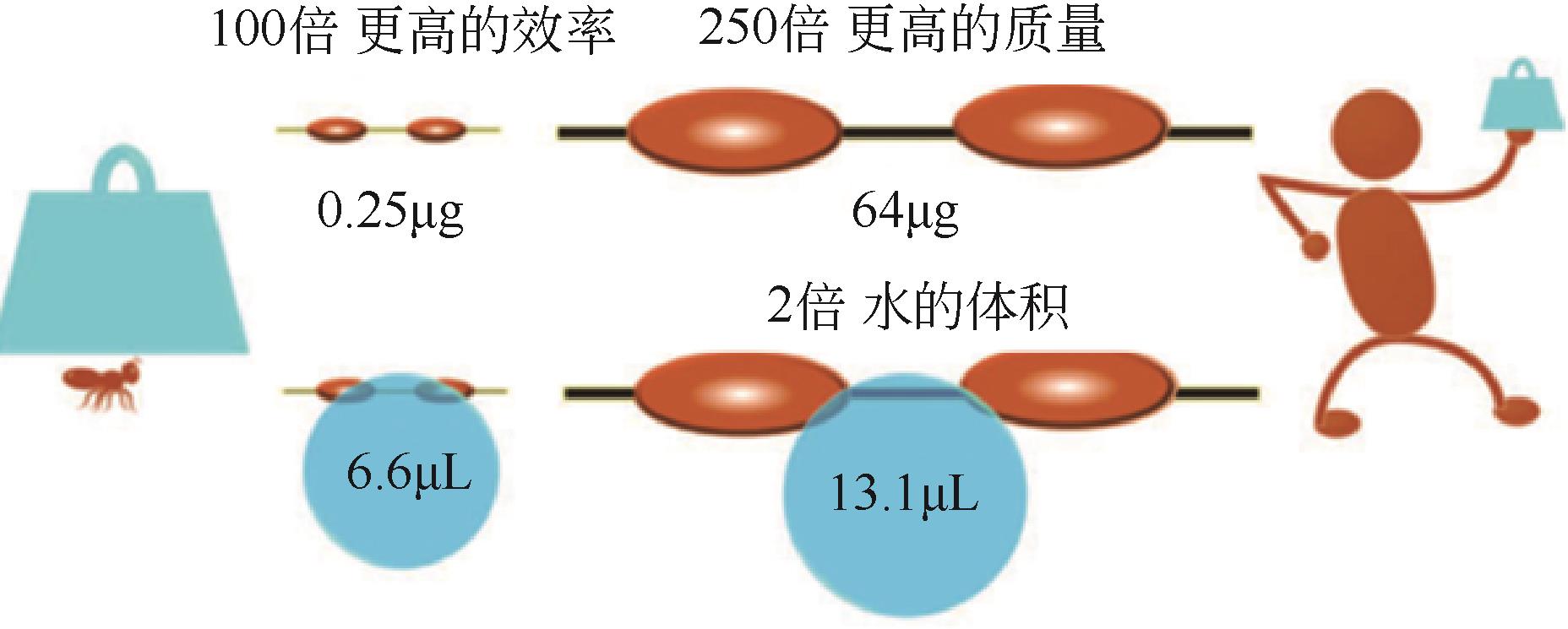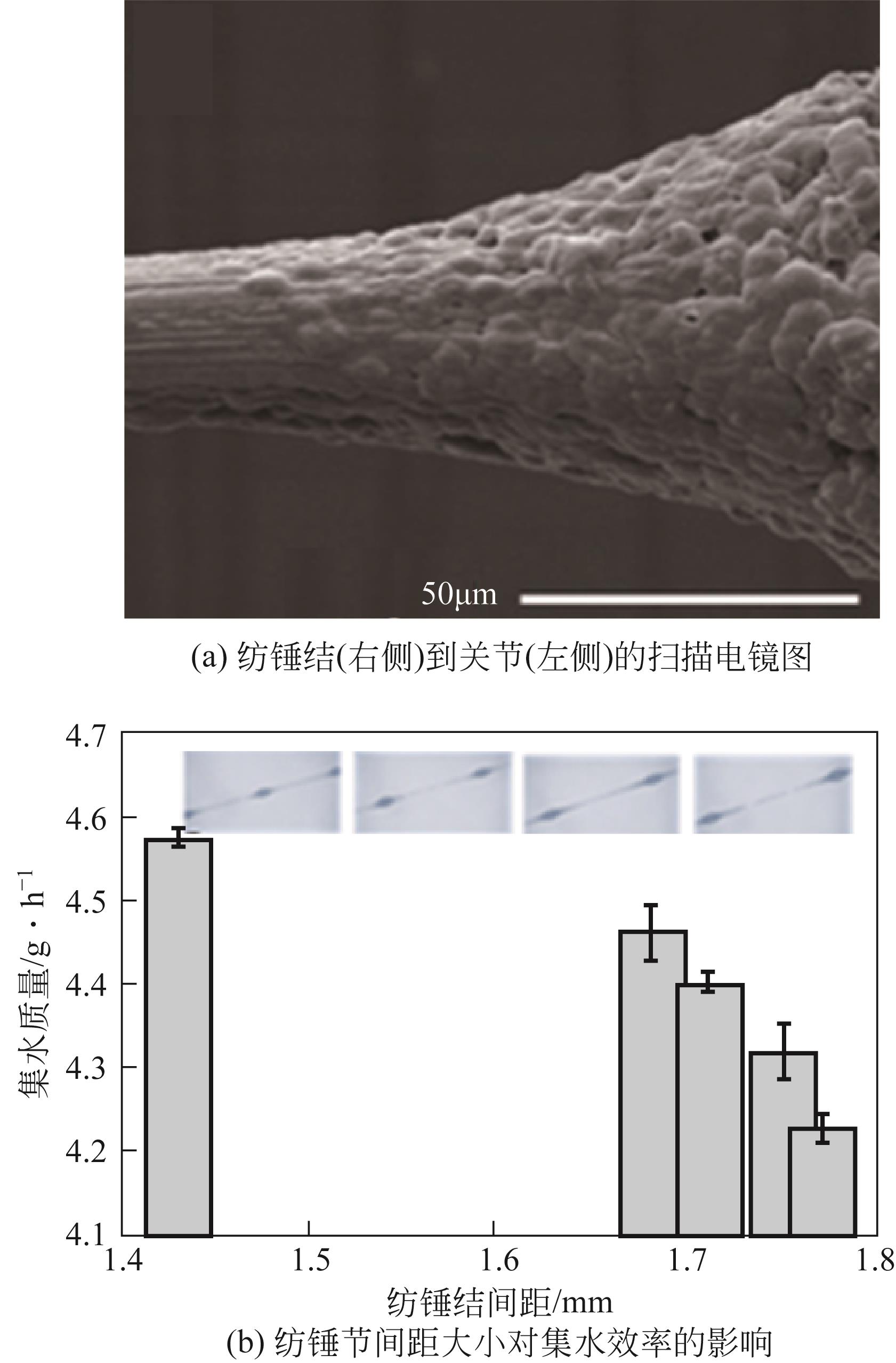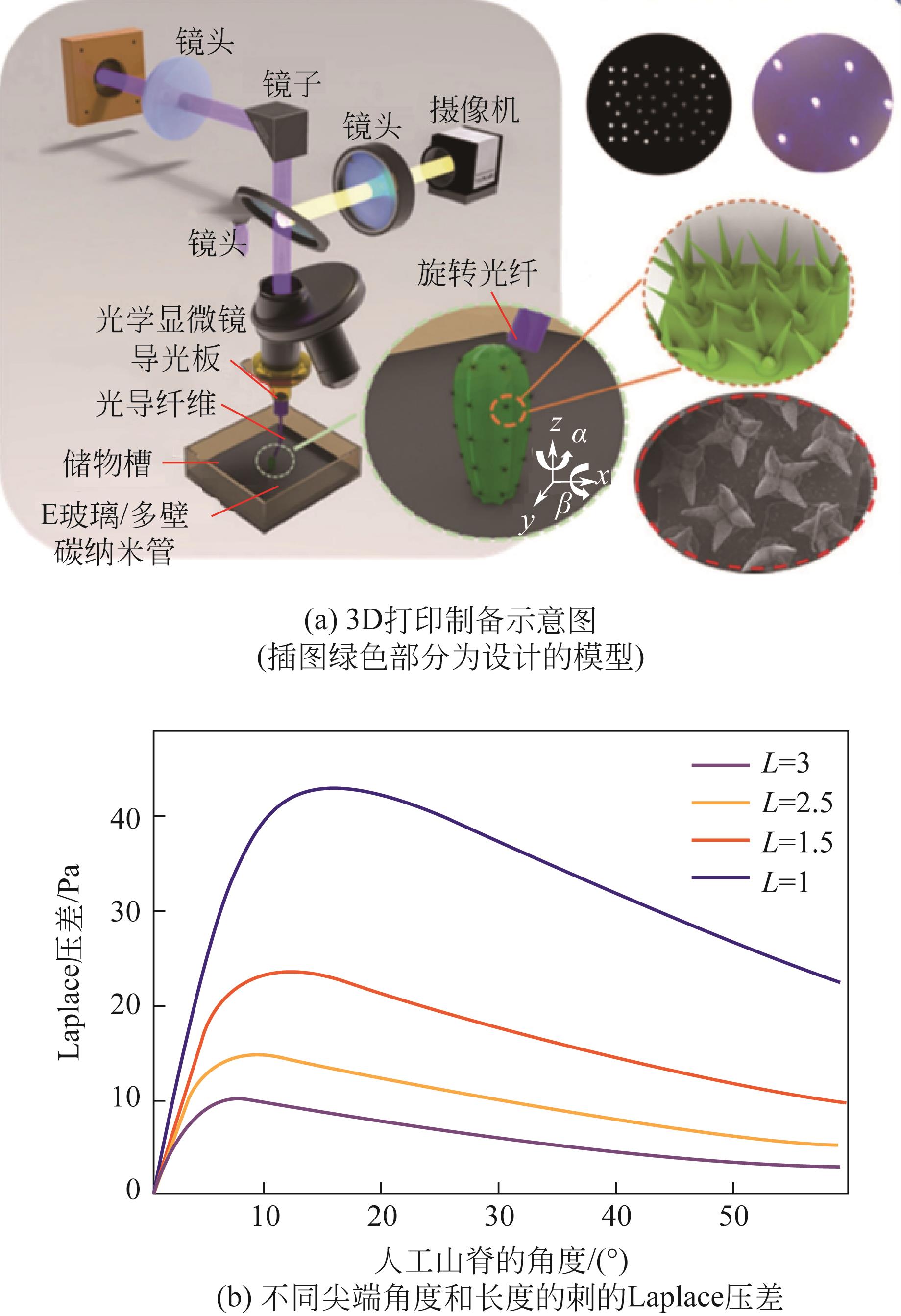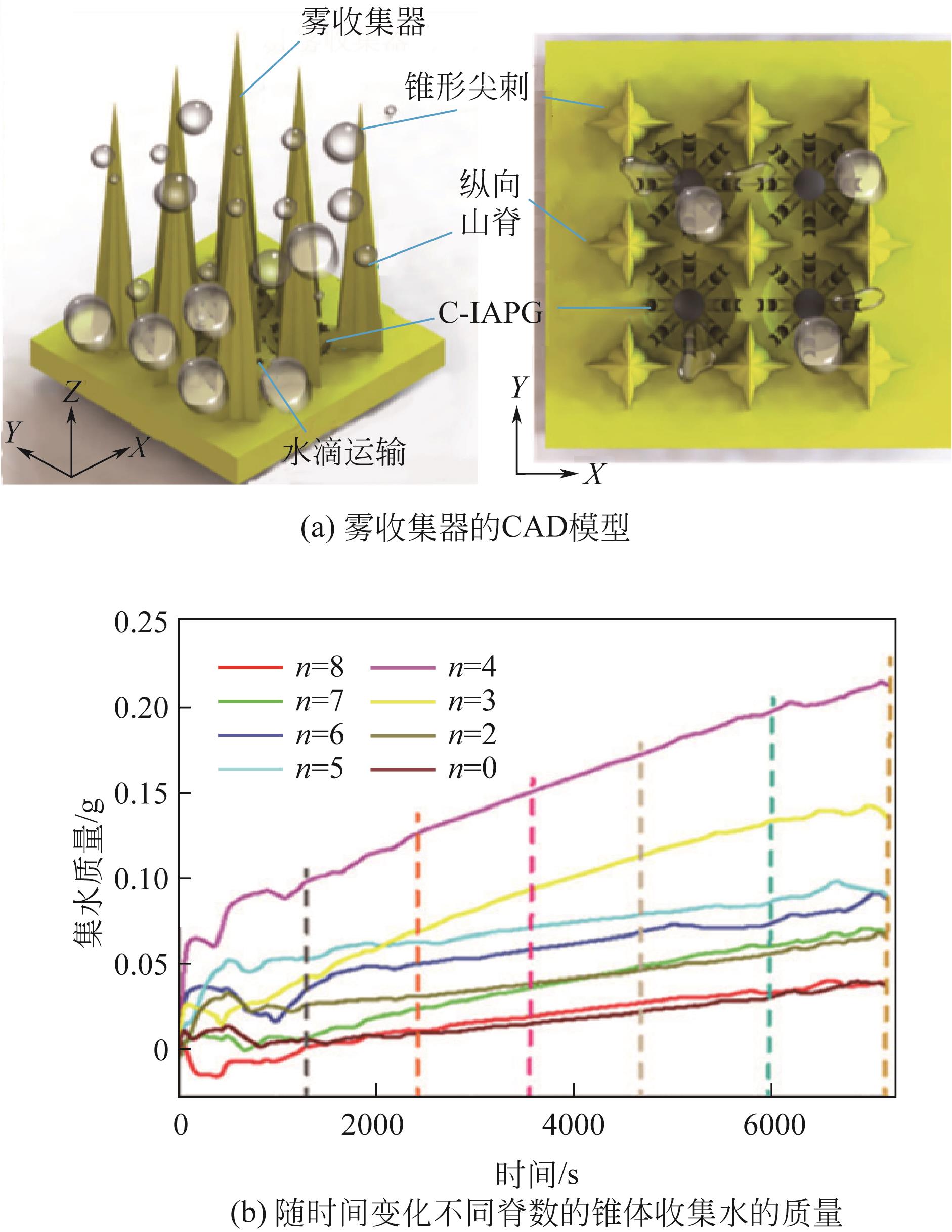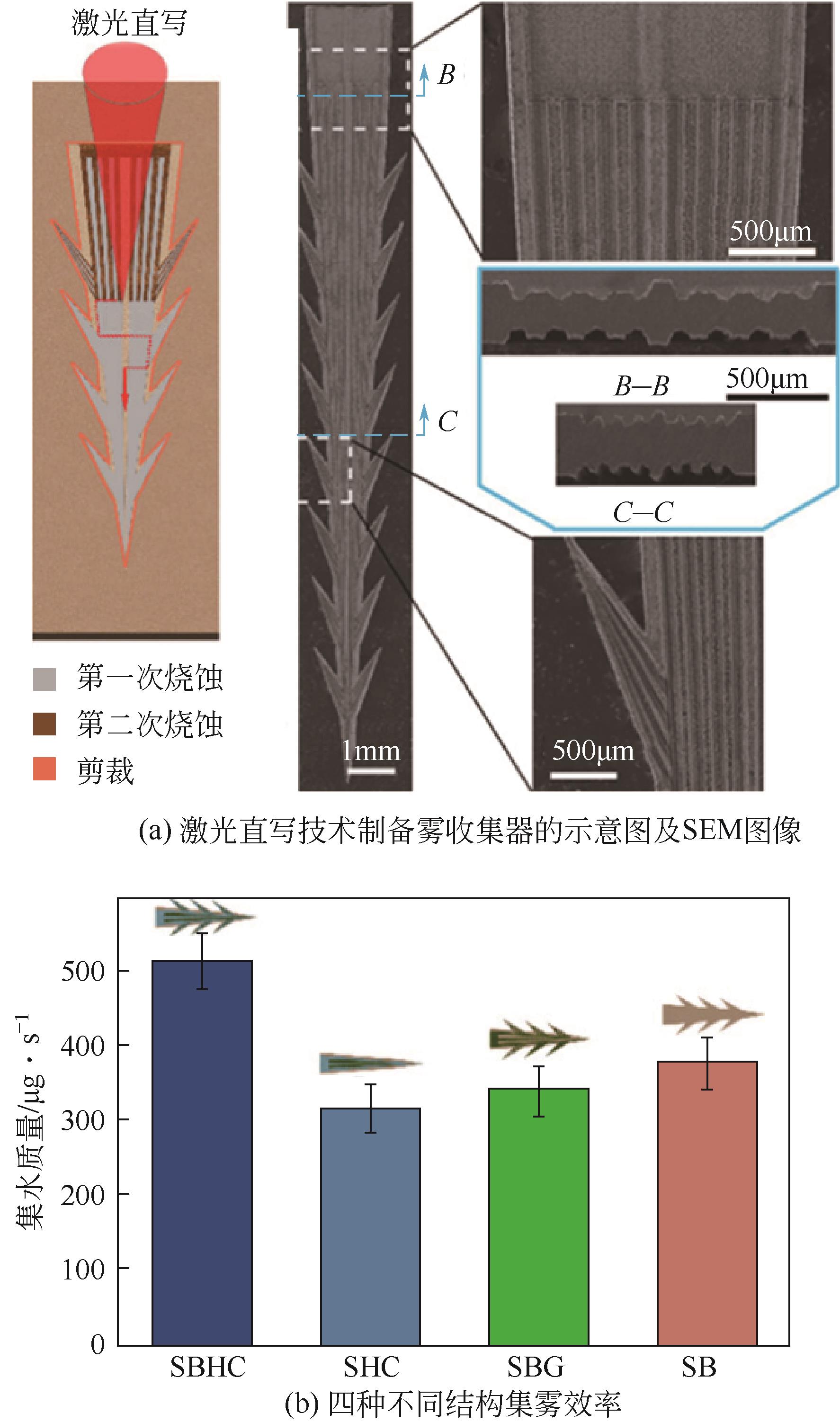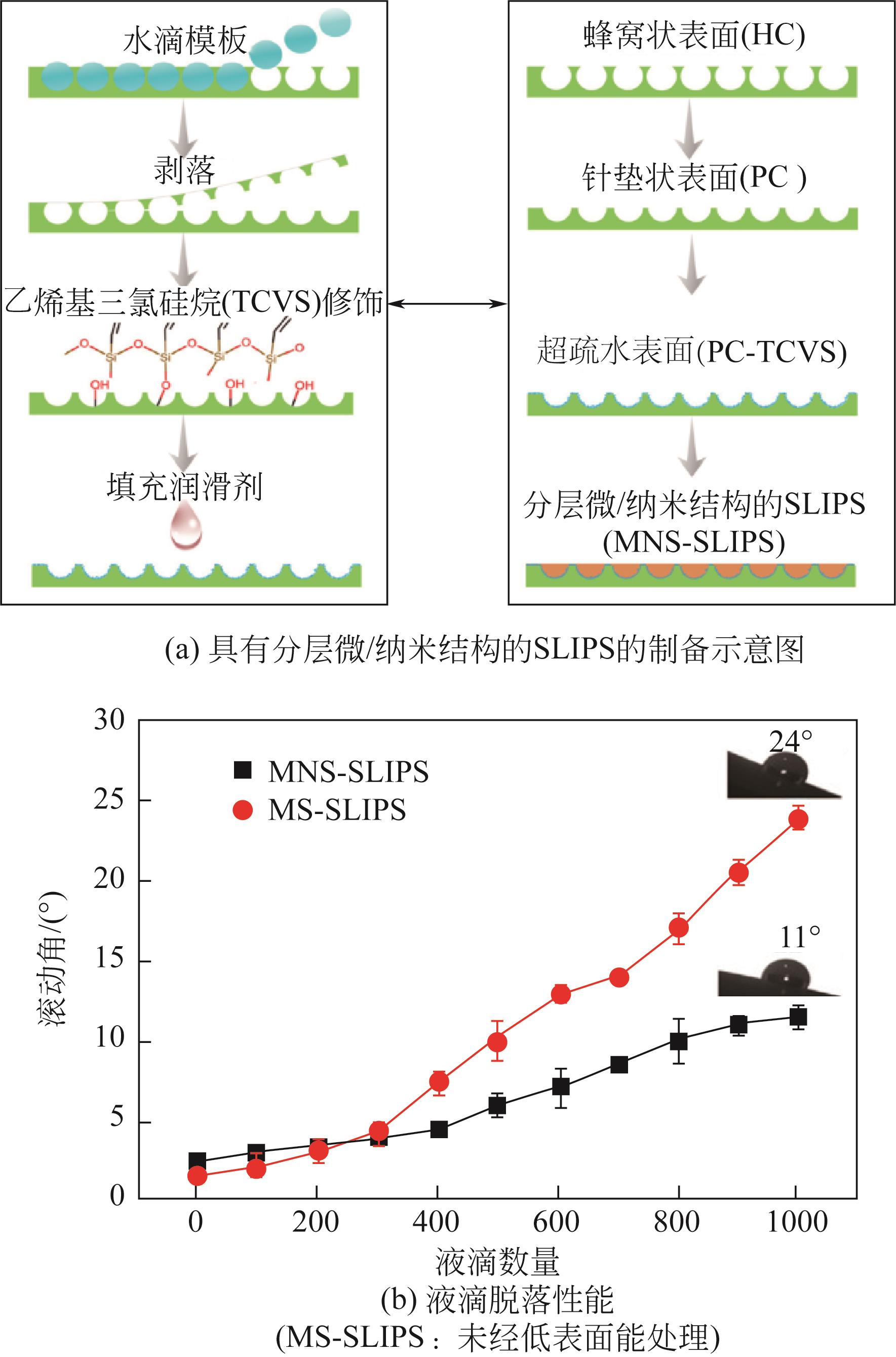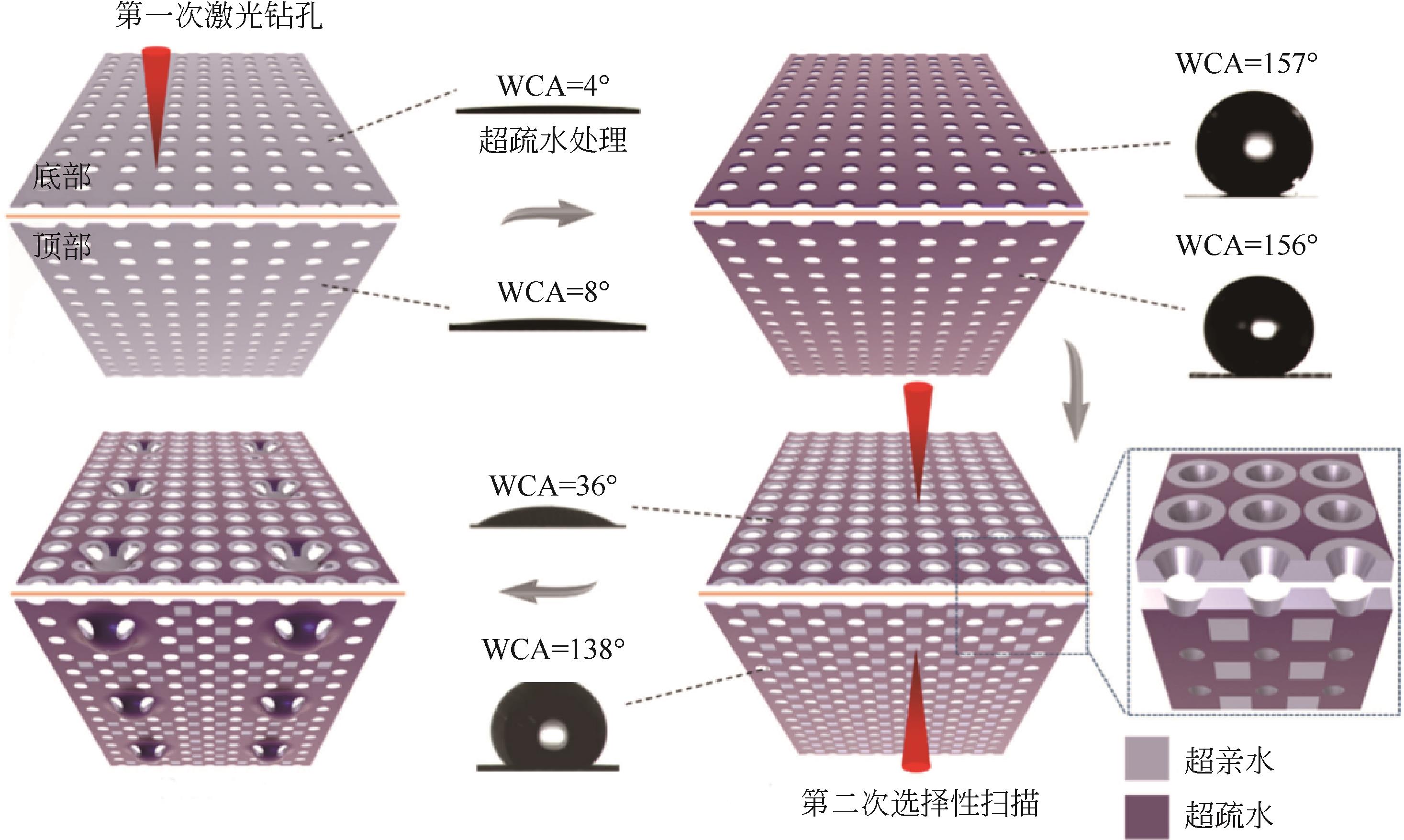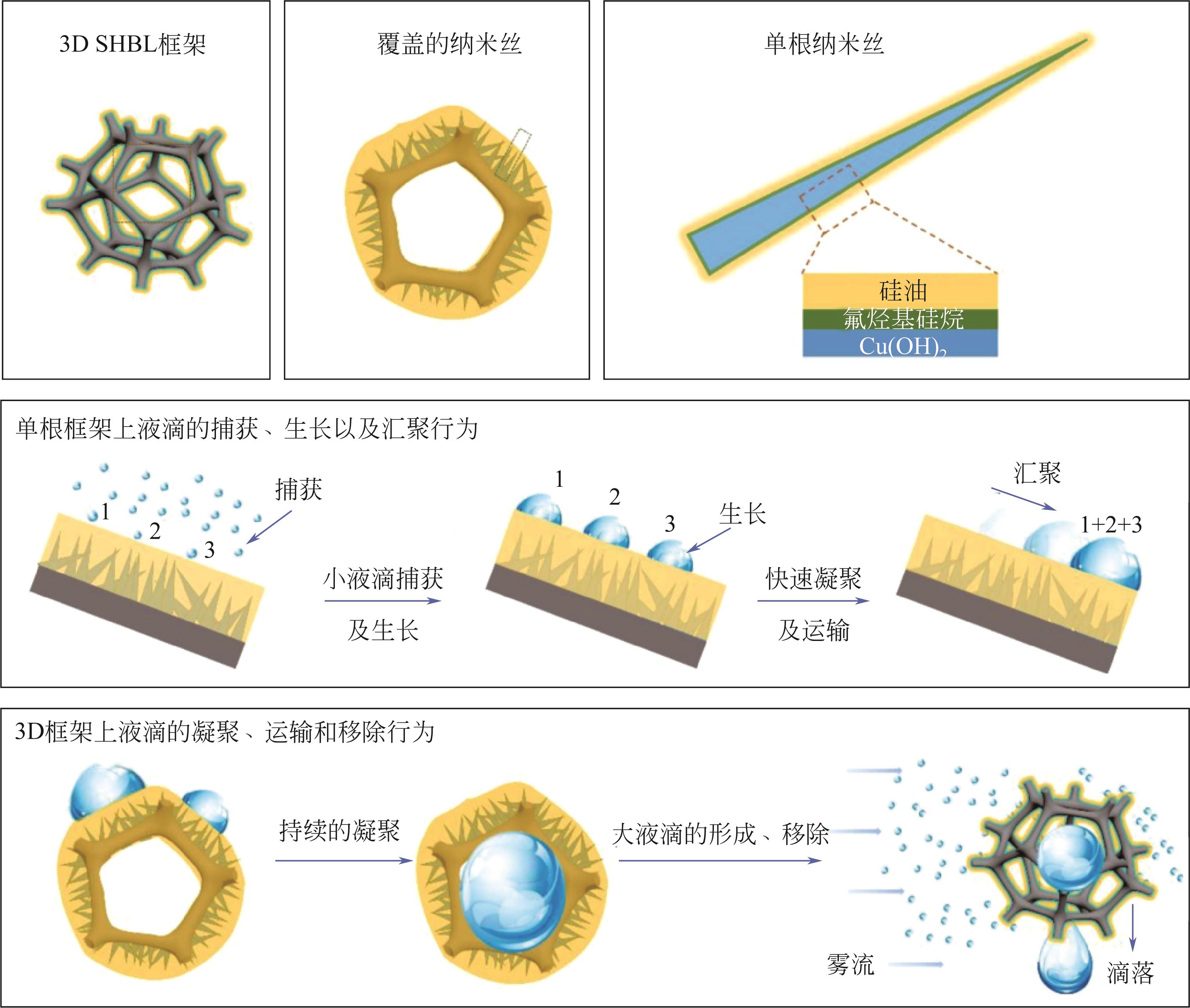化工进展 ›› 2023, Vol. 42 ›› Issue (5): 2486-2503.DOI: 10.16085/j.issn.1000-6613.2022-2100
仿生表面用于雾水收集的最新研究进展
- 1.中国石化北京化工研究院,北京 100013
2.大连理工大学化工学院,辽宁 大连 116024
-
收稿日期:2022-11-11修回日期:2023-01-03出版日期:2023-05-10发布日期:2023-06-02 -
通讯作者:陶胜洋 -
作者简介:李雪(1978—),女,硕士,研究方向为化工工艺开发。E-mail:lixue.bjhy@sinopec.com。 -
基金资助:辽宁省自然科学基金(2022-MS-143);大连市科技创新基金(2022JJ13SN098)
Recent advances in bionic surfaces for fog collection
LI Xue1( ), WANG Yanjun2, WANG Yuchao2, TAO Shengyang2(
), WANG Yanjun2, WANG Yuchao2, TAO Shengyang2( )
)
- 1.Sinopec Beijing Research Institute of Chemical Industry, Beijing 100013, China
2.School of Chemical Engineering, Dalian University of Technology, Dalian 116024, Liaoning, China
-
Received:2022-11-11Revised:2023-01-03Online:2023-05-10Published:2023-06-02 -
Contact:TAO Shengyang
摘要:
阐述了自然生物进行集水的两个理论阶段,重点介绍了仿生材料是通过实现对仿生功能结构与表面(浸润性)的有效调控,极大提升了材料集水效率。本文主要回顾了近几年来雾水收集仿生表面的重要研究进展,讨论不同仿生策略下发展的功能材料。其中主要介绍了蜘蛛丝纺锤结结构、仙人掌锥刺、Stenocara甲虫亲/疏水表面以及猪笼草润滑表面等功能结构与表面。综述了近几年仿生功能材料研发进展,其制备过程主要从简单的功能结构/表面性质模仿,结合对水传质过程理解,最终实现对结构与表面性质(浸润性)的重新构筑。首先,基于蜘蛛丝纺锤结以及仙人掌的锥刺所设计的仿生材料是对仿生功能结构的调控,研究结果表明实现结构调控能够强化液滴的运输,增强雾水收集效率。其次,Stenocara甲虫亲/疏水表面以及猪笼草润滑表面是实现对表面浸润性的调控,强化了液滴的捕获。接着介绍了不同功能耦合形成的多元仿生材料并总结了近年来仿生材料雾水收集效率。最后,对于仿生材料的实际应用以及未来的发展前景进行展望,指出简化材料制备、提升集水效率仍是实际发展过程的瓶颈问题,并表明了仿生材料的发展方向。
中图分类号:
引用本文
李雪, 王艳君, 王玉超, 陶胜洋. 仿生表面用于雾水收集的最新研究进展[J]. 化工进展, 2023, 42(5): 2486-2503.
LI Xue, WANG Yanjun, WANG Yuchao, TAO Shengyang. Recent advances in bionic surfaces for fog collection[J]. Chemical Industry and Engineering Progress, 2023, 42(5): 2486-2503.
| 序号 | 材料 | 结构 | 温度/℃ | 湿度/% | 雾水收集效率 | 参考文献 |
|---|---|---|---|---|---|---|
| 1 | 亲水性重组蜘蛛蛋白 | 纺锤结 | — | — | 26.4mm3·μg-1 | [ |
| 2 | 亲水性海藻酸钙及壳聚糖 | 纺锤结 | 室温 | — | 4.57g·h-1 | [ |
| 3 | 亲/疏水性相间的尼龙网 | 纺锤结 | — | — | 1688mg·h-1·cm-2 | [ |
| 4 | 复合亲水纳米纤维 | 纺锤结 | 25 | — | 0.83μL·s-1·mm-2 | [ |
| 5 | 亲水性铝箔 | 锥形尖刺结构 | 25 | 75±5 | 445mg·h-1·cm-2 | [ |
| 6 | 亲/疏水梯度性+亲水Janus铜网 | 锥形尖刺结构+Janus膜 | — | — | 7.05g·h-1·cm-2 | [ |
| 7 | 疏水液体树脂结构 | 锥形尖刺结构 | 25 | 75 | (109±24.5)mg·h-1 | [ |
| 8 | 疏水性滤纸 | 二维锥形尖刺结构 | — | — | (3780±40)mg·h-1·cm-2 | [ |
| 9 | 亲水铜片 | 锥形尖刺结构+分级通道 | 25 | 90 | 560μg·s-1 | [ |
| 10 | 亲/疏水性相间铜网 | 亲/疏水表面 | 25 | 85~90 | 1707.25mg·h-1·cm-2 | [ |
| 11 | 亲/疏水性相间乳液自组装表面 | 亲/疏水表面 | 25 | 80 | 3.402L ·h-1·m-2 | [ |
| 12 | 亲/疏水性相间铜板 | 亲/疏水表面 | 27±2 | 95±5 | (110.7±5.7)mg·h-1·cm-2 | [ |
| 13 | 亲/疏水性相间聚酯织物 | 亲/疏水表面 | — | — | 1432.7mg·h-1·cm-2 | [ |
| 14 | 超疏水三乙酸聚酯纤维薄膜 | 润滑表面 | 20 | 80 | 852mg·h-1·cm-2 | [ |
| 15 | 超疏水铜面 | 润滑表面 | 18±2 | 85 | 0.466g·h-1·cm-2 | [ |
| 16 | 亲水/超疏水性相间微型锥刺 | 锥形尖刺结构+亲/疏水表面 | 25 | 70~80 | 2.46g·h-1·cm-2 | [ |
| 17 | 超疏水锥形孔洞+超亲水/超疏水Janus铝箔 | 锥形尖刺结构+亲/疏水表面+Janus膜 | — | — | 11.4g·h-1 | [ |
| 18 | 疏水性锥刺+光滑泡沫桶 | 锥形尖刺结构+润滑表面 | 室温 | 90~95 | 0.8g·h-1·cm-2 | [ |
| 19 | 亲水性锥刺+亲/疏水性相间铜线 | 纺锤结+锥形尖刺结构+亲/疏水表面+润滑分层微通道 | — | — | 2.48g·h-1 | [ |
| 20 | 亲水性相间+锥形+叶脉结构+超疏水三乙酸纤维素表面 | 锥形尖刺结构+亲/疏水表面+润滑表面+叶脉结构 | 20 | 80 | (2166±71)mg·h-1·cm-2 | [ |
表1 雾水收集材料最新研究进展
| 序号 | 材料 | 结构 | 温度/℃ | 湿度/% | 雾水收集效率 | 参考文献 |
|---|---|---|---|---|---|---|
| 1 | 亲水性重组蜘蛛蛋白 | 纺锤结 | — | — | 26.4mm3·μg-1 | [ |
| 2 | 亲水性海藻酸钙及壳聚糖 | 纺锤结 | 室温 | — | 4.57g·h-1 | [ |
| 3 | 亲/疏水性相间的尼龙网 | 纺锤结 | — | — | 1688mg·h-1·cm-2 | [ |
| 4 | 复合亲水纳米纤维 | 纺锤结 | 25 | — | 0.83μL·s-1·mm-2 | [ |
| 5 | 亲水性铝箔 | 锥形尖刺结构 | 25 | 75±5 | 445mg·h-1·cm-2 | [ |
| 6 | 亲/疏水梯度性+亲水Janus铜网 | 锥形尖刺结构+Janus膜 | — | — | 7.05g·h-1·cm-2 | [ |
| 7 | 疏水液体树脂结构 | 锥形尖刺结构 | 25 | 75 | (109±24.5)mg·h-1 | [ |
| 8 | 疏水性滤纸 | 二维锥形尖刺结构 | — | — | (3780±40)mg·h-1·cm-2 | [ |
| 9 | 亲水铜片 | 锥形尖刺结构+分级通道 | 25 | 90 | 560μg·s-1 | [ |
| 10 | 亲/疏水性相间铜网 | 亲/疏水表面 | 25 | 85~90 | 1707.25mg·h-1·cm-2 | [ |
| 11 | 亲/疏水性相间乳液自组装表面 | 亲/疏水表面 | 25 | 80 | 3.402L ·h-1·m-2 | [ |
| 12 | 亲/疏水性相间铜板 | 亲/疏水表面 | 27±2 | 95±5 | (110.7±5.7)mg·h-1·cm-2 | [ |
| 13 | 亲/疏水性相间聚酯织物 | 亲/疏水表面 | — | — | 1432.7mg·h-1·cm-2 | [ |
| 14 | 超疏水三乙酸聚酯纤维薄膜 | 润滑表面 | 20 | 80 | 852mg·h-1·cm-2 | [ |
| 15 | 超疏水铜面 | 润滑表面 | 18±2 | 85 | 0.466g·h-1·cm-2 | [ |
| 16 | 亲水/超疏水性相间微型锥刺 | 锥形尖刺结构+亲/疏水表面 | 25 | 70~80 | 2.46g·h-1·cm-2 | [ |
| 17 | 超疏水锥形孔洞+超亲水/超疏水Janus铝箔 | 锥形尖刺结构+亲/疏水表面+Janus膜 | — | — | 11.4g·h-1 | [ |
| 18 | 疏水性锥刺+光滑泡沫桶 | 锥形尖刺结构+润滑表面 | 室温 | 90~95 | 0.8g·h-1·cm-2 | [ |
| 19 | 亲水性锥刺+亲/疏水性相间铜线 | 纺锤结+锥形尖刺结构+亲/疏水表面+润滑分层微通道 | — | — | 2.48g·h-1 | [ |
| 20 | 亲水性相间+锥形+叶脉结构+超疏水三乙酸纤维素表面 | 锥形尖刺结构+亲/疏水表面+润滑表面+叶脉结构 | 20 | 80 | (2166±71)mg·h-1·cm-2 | [ |
| 1 | ZHU Zhigao, XU Ying, LUO Yifei, et al. Porous evaporators with special wettability for low-grade heat-driven water desalination[J]. Journal of Materials Chemistry A, 2021, 9(2): 702-726. |
| 2 | LI Dingchen, LI Chuan, LI Jiawei, et al. Efficient corona discharge fog collector: Multiple mesh electrodes with electric field enhances fog harvesting[J]. Plasma Chemistry and Plasma Processing, 2022, 42(6): 1249-1264. |
| 3 | SONG Dong, BHUSHAN Bharat. Enhancement of water collection and transport in bioinspired triangular patterns from combined fog and condensation[J]. Journal of Colloid and Interface Science, 2019, 557: 528-536. |
| 4 | ZHAO Shuaifei, ZOU Linda, TANG Chuyang, et al. Recent developments in forward osmosis: Opportunities and challenges[J]. Journal of Membrane Science, 2012, 396: 1-21. |
| 5 | SAYED Enas Taha, SHEHATA Nabila, ABDELKAREEM Mohammad ALI, et al. Recent progress in environmentally friendly bio-electrochemical devices for simultaneous water desalination and wastewater treatment[J]. Science of the Total Environment, 2020, 748: 141046. |
| 6 | Barbara Ting Wei ANG, ZHANG Jiong, LIN Gabriel Jiajun, et al. Enhancing water harvesting through the cascading effect[J]. ACS Applied Materials & Interfaces, 2019, 11(30): 27464-27469. |
| 7 | EJEIAN M, ENTEZARI A, WANG R Z. Solar powered atmospheric water harvesting with enhanced LiCl/MgSO4/ACF composite[J]. Applied Thermal Engineering, 2020, 176: 115396. |
| 8 | XU Jiaxing, LI Tingxian, CHAO Jingwei, et al. Efficient solar-driven water harvesting from arid air with metal-organic frameworks modified by hygroscopic salt[J]. Angewandte Chemie International Edition, 2020, 59(13): 5202-5210. |
| 9 | JU Jie, YAO Xi, YANG Shuai, et al. Cactus stem inspired cone-arrayed surfaces for efficient fog collection[J]. Advance Functional Material, 2014, 24: 6933-6938. |
| 10 | KIM Seung-Hyun, KANG Hong Suk, SOHN Eun-Ho, et al. A strategy for preparing controllable, superhydrophobic, strongly sticky surfaces using SiO2@PVDF raspberry core-shell particles[J]. RSC Advances, 2021, 11(38): 23631-23636. |
| 11 | CHEN Yuan, WANG Lin, XUE Yan, et al. Bioinspired spindle-knotted fibers with a strong water-collecting ability from a humid environment[J]. Soft Matter, 2012, 8(45): 11450-11454. |
| 12 | DONG Shaojun, WANG Yang, PEI Ying, et al. Water collecting carbon nanotube yarn with biomimetic composition and structure[J]. Composites Communications, 2021, 28: 100960. |
| 13 | BAI Haoyu, ZHAO Tianhong, WANG Xinsheng, et al. Cactus kirigami for efficient fog harvesting: Simplifying a 3D cactus into 2D paper art[J]. Journal of Materials Chemistry A, 2020, 8(27): 13452-13458. |
| 14 | LEE Sang Joon, Nami HA, KIM Hyejeong. Superhydrophilic-superhydrophobic water harvester inspired by wetting property of cactus stem[J]. ACS Sustainable Chemistry & Engineering, 2019, 7(12): 10561-10569. |
| 15 | 陶先露, 杨玉明, 黎明, 等. 仿纳米布沙漠甲壳虫的绿色环保型水收集材料[J]. 武汉工程大学学报, 2022, 44(2): 174-179. |
| TAO Xianlu, YANG Yuming, LI Ming, et al. Eco-friendly water-collecting materials inspired by Namib Desert beetles[J]. Journal of Wuhan Institute of Technology, 2022, 44(2): 174-179. | |
| 16 | FAN Haifeng, GUO Zhiguang. WO3-based slippery coatings with long-term stability for efficient fog harvesting[J]. Journal of Colloid and Interface Science, 2021, 591: 418-428. |
| 17 | YIN Kai, DU Haifeng, DONG Xinran, et al. A simple way to achieve bioinspired hybrid wettability surface with micro/nanopatterns for efficient fog collection[J]. Nanoscale, 2017, 9(38): 14620-14626. |
| 18 | GUO Jie, HUANG Wei, GUO Zhiguang, et al. Design of a venation-like patterned surface with hybrid wettability for highly efficient fog harvesting[J]. Nano Letters, 2022, 22(7): 3104-3111. |
| 19 | WANG Zhecun, YANG Jianlin, SONG Shiyu, et al. Patterned, anti-fouling membrane with controllable wettability for ultrafast oil/water separation and liquid-liquid extraction[J]. Chemical Communications, 2020, 56(80): 12045-12048. |
| 20 | YANG Xiaolong, LIU Xin, LI Juan, et al. Directional transport of water droplets on superhydrophobic aluminium alloy surface[J]. Micro & Nano Letters, 2015, 10(7): 343-346. |
| 21 | WANG Yuchao, ZHANG Lianbin, WU Jinbo, et al. A facile strategy for the fabrication of a bioinspired hydrophilic-superhydrophobic patterned surface for highly efficient fog-harvesting[J]. Journal of Materials Chemistry A, 2015, 3(37): 18963-18969. |
| 22 | CAO Moyuan, JU Jie, LI Kan, et al. Facile and large-scale fabrication of a cactus-inspired continuous fog collector[J]. Advanced Functional Materials, 2014, 24(21): 3235-3240. |
| 23 | REN Feifei, LI Guoqiang, ZHANG Zhen, et al. A single-layer Janus membrane with dual gradient conical micropore arrays for self-driving fog collection[J]. Journal of Materials Chemistry A, 2017, 5(35): 18403-18408. |
| 24 | ZHENG Yongmei, BAI Hao, HUANG Zhongbing, et al. Directional water collection on wetted spider silk[J]. Nature, 2010, 463(7281): 640-643. |
| 25 | LORENCEAU Elise, QUERE David. Drops on a conical wire[J]. Journal of Fluid Mechanics, 2004, 510: 29-45. |
| 26 | ZHANG Chunhui, ZHANG Bo, MA Hongyu, et al. Bioinspired pressure-tolerant asymmetric slippery surface for continuous self-transport of gas bubbles in aqueous environment[J]. ACS Nano, 2018, 12(2): 2048-2055. |
| 27 | CHAUDHURY M K, WHITESIDES G M. How to make water run uphill[J]. Science, 1992, 256(5063): 1539-1541. |
| 28 | YU Zhihua, ZHU Tianxue, ZHANG Jichao, et al. Fog harvesting devices inspired from single to multiple creatures: Current progress and future perspective[J]. Advanced Functional Materials, 2022, 32(26): 2270148. |
| 29 | BAI Hao, TIAN Xuelin, ZHENG Yongmei, et al. Direction controlled driving of tiny water drops on bioinspired artificial spider silks[J]. Advanced Materials, 2010, 22(48): 5521-5525. |
| 30 | CHEN Yuan, ZHENG Yongmei. Bioinspired micro-/nanostructure fibers with a water collecting property[J]. Nanoscale, 2014, 6(14): 7703-7714. |
| 31 | 张松楠, 李红艳, 刘佳明, 等. 纺织集水材料的制备及研究进展[J]. 纺织高校基础科学学报, 2022, 35(1): 88-96. |
| ZHANG Songnan, LI Hongyan, LIU Jiaming, et al. Preparation and research progress of textile water collecting materials[J]. Basic Sciences Journal of Textile Universities, 2022, 35(1): 88-96. | |
| 32 | MERRIUM Sabah, Zulfiqar ALI, Muhammad HABIB-UR-RAHMAN, et al. Leaf rolling and leaf angle improve fog capturing and transport in wheat; adaptation for drought stress in an arid climate[J]. Botanical Studies, 2022, 63(1): 1-13. |
| 33 | HAKEEM Sadia, Zulfiqar ALI, SADDIQUE Muhammad Abu Bakar, et al. Leaf prickle hairs and longitudinal grooves help wheat plants capture air moisture as a water-smart strategy for a changing climate[J]. Planta, 2021, 254: 1-11. |
| 34 | GÜRSOY M, HARRIS M T, DOWNING J O, et al. Bioinspired fog capture and channel mechanism based on the arid climate plant Salsola crassa[J]. Colloids and Surfaces A: Physicochemical and Engineering Aspects, 2017, 529: 195-202. |
| 35 | YAMADA Yutaka, SAKATA Eiji, ISOBE Kazuma, et al. Wettability difference induced out-of-plane unidirectional droplet transport for efficient fog harvesting[J]. ACS Applied Materials & Interfaces, 2021, 13(29): 35079-35085. |
| 36 | 丁雅玉, 苏亚辉, 陈亮. 纳秒激光加工(超)疏水/(超)亲水铝膜的润湿性和雾水收集实验研究[J]. 激光与光电子学进展, 2020, 57(11): 144-150. |
| DING Yayu, SU Yahui, CHEN Liang. Experimentally investigating wettability and fog collection characteristics of (super) hydrophobic/(super)hydrophilic aluminum membranes processed by nanosecond laser[J]. Laser & Optoelectronics Progress, 2020, 57(11): 144-150. | |
| 37 | 周慧, 郭志光. 高效集水仿生超浸润材料的研究进展[J]. 应用化学, 2022, 39(1): 154-176. |
| ZHOU Hui, GUO Zhiguang. Recent developments of biomimetic superwetting materials for high efficiency water collection[J]. Chinese Journal of Applied Chemistry, 2022, 39(1): 154-176. | |
| 38 | ZHAO Lin, SONG Cheng, ZHANG Miaoxin, et al. Bioinspired heterostructured bead-on-string fibers via controlling the wet-assembly of nanoparticles[J]. Chemical Communications, 2014, 50(73): 10651-10654. |
| 39 | ZHANG Songnan, HUANG Jianying, CHEN Zhong, et al. Bioinspired special wettability surfaces: From fundamental research to water harvesting applications[J]. Small, 2017, 13(3): 1602992. |
| 40 | BAI Hao, JU Jie, SUN Ruize, et al. Controlled fabrication and water collection ability of bioinspired artificial spider silks[J]. Advanced Materials, 2011, 23(32): 3708-3711. |
| 41 | VENKATESAN Harun, CHEN Jianming, LIU Haiyang, et al. A spider-capture-silk-like fiber with extremely high-volume directional water collection[J]. Advanced Functional Materials, 2020, 30(30): 2002437. |
| 42 | LIU Yufang, YANG Nan, LI Xin, et al. Water harvesting of bioinspired microfibers with rough spindle-knots from microfluidics[J]. Small, 2020, 16(9): 1901819. |
| 43 | CHEN Wei, LI Shanpeng, GUO Zhiguang. Water droplet transport on a nylon mesh with graded structures by facile PMMA spraying and etching process inspired by spider silk[J]. Materials Letters, 2021, 291: 129546. |
| 44 | LIU Huanyu, WANG Yiying, YIN Wei, et al. Highly efficient water harvesting of bioinspired spindle-knotted microfibers with continuous hollow channels[J]. Journal of Materials Chemistry A, 2022, 10(13): 7130-7137. |
| 45 | LIU Yufang, YANG Nan, GAO Chunlei, et al. Bioinspired nanofibril-humped fibers with strong capillary channels for fog capture[J]. ACS Applied Materials & Interfaces, 2020, 12(25): 28876-28884. |
| 46 | GUO Chi, WANG Chengquan, HUANG Qi, et al. 3D-printed spider-web structures for highly efficient water collection[J]. Heliyon, 2022, 8(8): e10007. |
| 47 | JU Jie, BAI Hao, ZHENG Yongmei, et al. A multi-structural and multi-functional integrated fog collection system in cactus[J]. Nature Communications, 2012, 3: 1247. |
| 48 | ZHANG Fan, GUO Zhiguang. Bioinspired materials for water-harvesting: Focusing on microstructure designs and the improvement of sustainability[J]. Materials Advances, 2020, 1(8): 2592-2613. |
| 49 | JARIMI Hasila, POWELL Richard, RIFFAT Saffa. Review of sustainable methods for atmospheric water harvesting[J]. International Journal of Low-Carbon Technologies, 2020, 15(2): 253-276. |
| 50 | JU Jie, XIAO Kai, YAO Xi, et al. Bioinspired conical copper wire with gradient wettability for continuous and efficient fog collection[J]. Advanced Materials, 2013, 25(41): 5937-5942. |
| 51 | YI Shengzhu, WANG Jian, CHEN Zhipeng, et al. Cactus-inspired conical spines with oriented microbarbs for efficient fog harvesting[J]. Advanced Materials Technologies, 2019, 4(12): 1900727. |
| 52 | LI Xiangjia, YANG Yang, LIU Luyang, et al. 3D-printed cactus-inspired spine structures for highly efficient water collection[J]. Advanced Materials Interfaces, 2020, 7(3): 1901752. |
| 53 | FAN Junzhe, YANG Zhengqing, SUN Wen, et al. Regioselective deposition of hydrophilic sites to enhance the fog collection performance of hydrophilic-hydrophobic surface[J]. Colloids and Surfaces A: Physicochemical and Engineering Aspects, 2022, 650: 129574. |
| 54 | HENG Xin, XIANG Mingming, LU Zhihui, et al. Branched ZnO wire structures for water collection inspired by cacti[J]. ACS Applied Materials & Interfaces, 2014, 6(11): 8032-8041. |
| 55 | CHENG Yan, ZHANG Songnan, LIU Shengkai, et al. Fog catcher brushes with environmental friendly slippery alumina micro-needle structured surface for efficient fog-harvesting[J]. Journal of Cleaner Production, 2021, 315: 127862. |
| 56 | SONG Yunyun, YU Zhaopeng, DONG Liming, et al. Cactus-inspired Janus membrane with a conical array of wettability gradient for efficient fog collection[J]. Langmuir: the ACS Journal of Surface and Colloids, 2021, 37(46): 13703-13711. |
| 57 | GURERA Dev, BHUSHAN Bharat. Optimization of bioinspired conical surfaces for water collection from fog[J]. Journal of Colloid and Interface Science, 2019, 551: 26-38. |
| 58 | MAHMOOD Awais, CHEN Lei, CHEN Shuai, et al. Nature-inspired design of conical array for continuous and efficient fog collection application[J]. Colloid and Interface Science Communications, 2020, 37: 100283. |
| 59 | LIU Luyang, LIU Siying, SCHELP Michael, et al. Rapid 3D printing of bioinspired hybrid structures for high-efficiency fog collection and water transportation[J]. ACS Applied Materials & Interfaces, 2021, 13(24): 29122-29129. |
| 60 | WANG Jian, YI Shengzhu, YANG Zhilun, et al. Laser direct structuring of bioinspired spine with backward microbarbs and hierarchical microchannels for ultrafast water transport and efficient fog harvesting[J]. ACS Applied Materials & Interfaces, 2020, 12(18): 21080-21087. |
| 61 | PARKER Andrew R, LAWRENCE Chris R. Water capture by a desert beetle[J]. Nature, 2001, 414(6859): 33-34. |
| 62 | ZHONG Lieshuang, ZHU Hai, WU Yang, et al. Understanding how surface chemistry and topography enhance fog harvesting based on the superwetting surface with patterned hemispherical bulges[J]. Journal of Colloid and Interface Science, 2018, 525: 234-242. |
| 63 | FENG Jing, ZHONG Lieshuang, GUO Zhiguang. Sprayed hieratical biomimetic superhydrophilic-superhydrophobic surface for efficient fog harvesting[J]. Chemical Engineering Journal, 2020, 388: 124283. |
| 64 | BAI Hao, WANG Lin, JU Jie, et al. Efficient water collection on integrative bioinspired surfaces with star-shaped wettability patterns[J]. Advanced Materials, 2014, 26(29): 5025-5030. |
| 65 | ZHU Hai, GUO Zhiguang. Hybrid engineered materials with high water-collecting efficiency inspired by Namib Desert beetles[J]. Chemical Communications, 2016, 52(41): 6809-6812. |
| 66 | GE Peng, WANG Shuli, ZHANG Junhu, et al. Micro-/nanostructures meet anisotropic wetting: From preparation methods to applications[J]. Materials Horizons, 2020, 7(10): 2566-2595. |
| 67 | WANG Xikui, ZENG Jia, YU Xinquan, et al. Beetle-like droplet-jumping superamphiphobic coatings for enhancing fog collection of sheet arrays[J]. RSC Advances, 2020, 10(1): 282-288. |
| 68 | LEI Jun, GUO Zhiguang. A fog-collecting surface mimicking the Namib beetle: Its water collection efficiency and influencing factors[J]. Nanoscale, 2020, 12(13): 6921-6936. |
| 69 | WANG Yi, ZHAO Weinan, HAN Mei, et al. Sustainable superhydrophobic surface with tunable nanoscale hydrophilicity for water harvesting applications[J]. Angewandte Chemie International Edition, 2022, 61(10): 202115238. |
| 70 | WANG Zhecun, LI Hanzhen, YANG Xin, et al. Multi-bioinspired Janus copper mesh for improved gravity-irrelevant directional water droplet and flow transport[J]. Langmuir, 2022, 38(6): 2137-2144. |
| 71 | YU Zhenwei, YUN Frank F, WANG Yanqin, et al. Desert beetle-inspired superwettable patterned surfaces for water harvesting[J]. Small, 2017, 13(36): 1701403. |
| 72 | WANG Jing, GUO Ying, PAN Guoyuan, et al. Hybrid wettability surfaces with hydrophobicity and hydrophilicity for fog harvesting[J]. Colloids and Surfaces A: Physicochemical and Engineering Aspects, 2022, 650: 129555. |
| 73 | HOU Kongyang, LI Xiaoyang, LI Qiang, et al. Tunable wetting patterns on superhydrophilic/superhydrophobic hybrid surfaces for enhanced dew-harvesting efficacy[J]. Advanced Materials Interfaces, 2020, 7(2): 1901683. |
| 74 | LI Chen, JIANG Lan, HU Jie, et al. Superhydrophilic-superhydrophobic multifunctional Janus foam fabrication using a spatially shaped femtosecond laser for fog collection and detection[J]. ACS Applied Materials & Interfaces, 2022, 14(7): 9873-9881. |
| 75 | YU Zhihua, ZHANG Huimei, HUANG Jianying, et al. Namib desert beetle inspired special patterned fabric with programmable and gradient wettability for efficient fog harvesting[J]. Journal of Materials Science & Technology, 2021, 61: 85-92. |
| 76 | YU Zhihua, LI Shuhui, LIU Mingming, et al. A dual-biomimetic knitted fabric with a manipulable structure and wettability for highly efficient fog harvesting[J]. Journal of Materials Chemistry A, 2022, 10(1): 304-312. |
| 77 | CHEN Huawei, ZHANG Pengfei, ZHANG Liwen, et al. Continuous directional water transport on the peristome surface of Nepenthes alata[J]. Nature, 2016, 532(7597): 85-89. |
| 78 | LI Jing, ZHOU Yingluo, WANG Weibing, et al. A bio-inspired superhydrophobic surface for fog collection and directional water transport[J]. Journal of Alloys and Compounds, 2020, 819: 152968. |
| 79 | WANG Yuanfeng, QIAN Baitai, LAI Chuilin, et al. Flexible slippery surface to manipulate droplet coalescence and sliding, and its practicability in wind-resistant water collection[J]. ACS Applied Materials & Interfaces, 2017, 9(29): 24428-24432. |
| 80 | HUANG Yu, STOGIN Birgitt Boschitsch, SUN Nan, et al. A switchable cross-species liquid repellent surface[J]. Advanced Materials, 2017, 29(8):1604641. |
| 81 | FENG Rui, XU Chen, SONG Fei, et al. A bioinspired slippery surface with stable lubricant impregnation for efficient water harvesting[J]. ACS Applied Materials & Interfaces, 2020, 12(10): 12373-12381. |
| 82 | HAN Xutong, GUO Zhiguang. Lubricant-infused three-dimensional frame composed of a micro/nanospinous ball cluster structure with salient durability and superior fog harvesting capacity[J]. ACS Applied Materials & Interfaces, 2021, 13(38): 46192-46201. |
| 83 | HU Rongjun, WANG Nü, HOU Lanlan, et al. A bioinspired hybrid membrane with wettability and topology anisotropy for highly efficient fog collection[J]. Journal of Materials Chemistry A, 2019, 7(1): 124-132. |
| 84 | PENG Linhui, CHEN Keqiu, CHEN Deyi, et al. Study on the enhancing water collection efficiency of cactus- and beetle-like biomimetic structure using UV-induced controllable diffusion method and 3D printing technology[J]. RSC Advances, 2021, 11(24): 14769-14776. |
| 85 | SU Yahui, CHEN Liang, JIAO Yunlong, et al. Hierarchical hydrophilic/hydrophobic/bumpy Janus membrane fabricated by femtosecond laser ablation for highly efficient fog harvesting[J]. ACS Applied Materials & Interfaces, 2021, 13(22): 26542-26550. |
| 86 | PEI Wenle, LI Jinghui, GUO Zhenyu, et al. Excellent fog harvesting performance of liquid-infused nano-textured 3D frame[J]. Chemical Engineering Journal, 2021, 409: 128180. |
| 87 | WANG Qianqian, HE Yi, GENG Xinxin, et al. Enhanced fog harvesting through capillary-assisted rapid transport of droplet confined in the given microchannel[J]. ACS Applied Materials & Interfaces, 2021, 13(40): 48292-48300. |
| 88 | FENG Rui, SONG Fei, XU Chen, et al. A quadruple-biomimetic surface for spontaneous and efficient fog harvesting[J]. Chemical Engineering Journal, 2021, 422: 130119. |
| [1] | 张杰, 白忠波, 冯宝鑫, 彭肖林, 任伟伟, 张菁丽, 刘二勇. PEG及其复合添加剂对电解铜箔后处理的影响[J]. 化工进展, 2023, 42(S1): 374-381. |
| [2] | 赵景超, 谭明. 表面活性剂对电渗析减量化工业含盐废水的影响[J]. 化工进展, 2023, 42(S1): 529-535. |
| [3] | 孙玉玉, 蔡鑫磊, 汤吉海, 黄晶晶, 黄益平, 刘杰. 反应精馏合成甲基丙烯酸甲酯工艺优化及节能[J]. 化工进展, 2023, 42(S1): 56-63. |
| [4] | 邵博识, 谭宏博. 锯齿波纹板对挥发性有机物低温脱除过程强化模拟分析[J]. 化工进展, 2023, 42(S1): 84-93. |
| [5] | 盛维武, 程永攀, 陈强, 李小婷, 魏嘉, 李琳鸽, 陈险峰. 微气泡和微液滴双强化脱硫反应器操作分析[J]. 化工进展, 2023, 42(S1): 142-147. |
| [6] | 黄益平, 李婷, 郑龙云, 戚傲, 陈政霖, 史天昊, 张新宇, 郭凯, 胡猛, 倪泽雨, 刘辉, 夏苗, 主凯, 刘春江. 三级环流反应器中气液流动与传质规律[J]. 化工进展, 2023, 42(S1): 175-188. |
| [7] | 杨寒月, 孔令真, 陈家庆, 孙欢, 宋家恺, 王思诚, 孔标. 微气泡型下向流管式气液接触器脱碳性能[J]. 化工进展, 2023, 42(S1): 197-204. |
| [8] | 陈匡胤, 李蕊兰, 童杨, 沈建华. 质子交换膜燃料电池气体扩散层结构与设计研究进展[J]. 化工进展, 2023, 42(S1): 246-259. |
| [9] | 刘炫麟, 王驿凯, 戴苏洲, 殷勇高. 热泵中氨基甲酸铵分解反应特性及反应器结构优化[J]. 化工进展, 2023, 42(9): 4522-4530. |
| [10] | 王谨航, 何勇, 史伶俐, 龙臻, 梁德青. 气体水合物阻聚剂研究进展[J]. 化工进展, 2023, 42(9): 4587-4602. |
| [11] | 王晨, 白浩良, 康雪. 大功率UV-LED散热与纳米TiO2光催化酸性红26耦合系统性能[J]. 化工进展, 2023, 42(9): 4905-4916. |
| [12] | 张振, 李丹, 陈辰, 吴菁岚, 应汉杰, 乔浩. 吸附树脂对唾液酸的分离纯化[J]. 化工进展, 2023, 42(8): 4153-4158. |
| [13] | 张超, 杨鹏, 刘广林, 赵伟, 杨绪飞, 张伟, 宇波. 表面微结构对阵列微射流沸腾换热的影响[J]. 化工进展, 2023, 42(8): 4193-4203. |
| [14] | 李洞, 王倩倩, 张亮, 李俊, 付乾, 朱恂, 廖强. 非水系纳米流体热再生液流电池串联堆性能特性[J]. 化工进展, 2023, 42(8): 4238-4246. |
| [15] | 张凯, 吕秋楠, 李刚, 李小森, 莫家媚. 南海海泥中甲烷水合物的形貌及赋存特性[J]. 化工进展, 2023, 42(7): 3865-3874. |
| 阅读次数 | ||||||
|
全文 |
|
|||||
|
摘要 |
|
|||||


